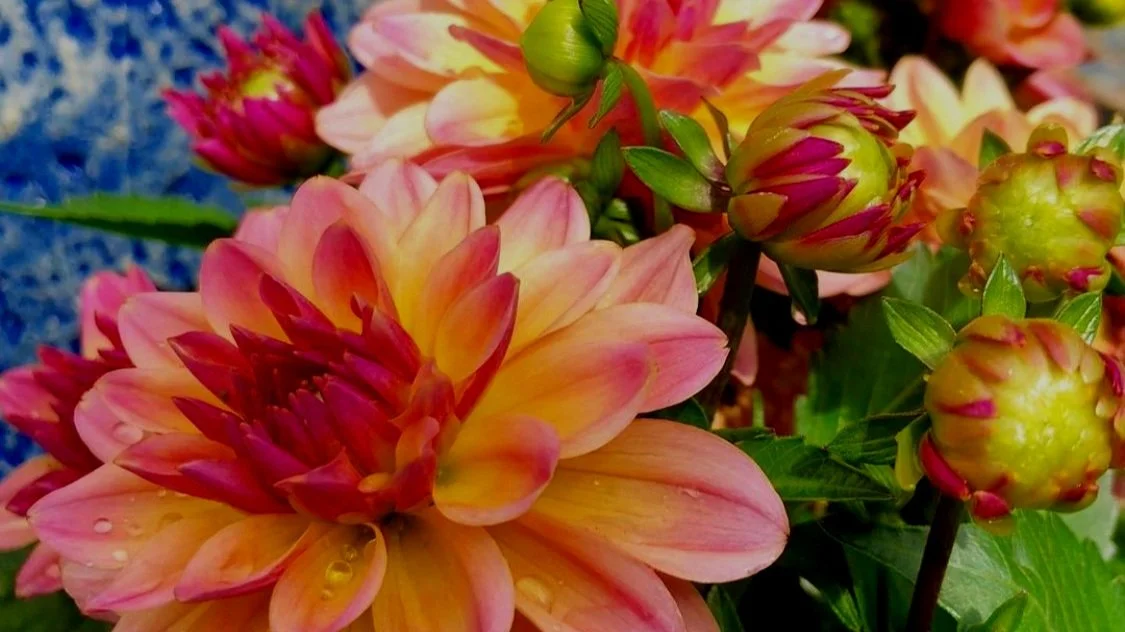Summer-blooming bulbs, like Lilies, Dahlias and Gladiolus (to name just a few), have a very warm spot in my heart. I have fond memories as a child of planting Glads and coming home from school every day to check their progress, feeling the stems for potential flower buds, until finally they would emerge into their glorious colors. It was absolute magic for a youngster such as myself. You too can experience those same feelings (no matter what your age), simply by heading on down to the garden center and purchasing some of these very same bulbs. Here is a rundown on most of the choices for summer bloomers that can be planted now for summer and fall color…
Dahlias: These easy-to-grow bulbs, that are native to Mexico, Central America, and South America, come in an incredible array of colors (everything except blue) and flower forms. You can find small “bedding” forms that only reach a foot tall, all the way up to six footers that will need staking to keep them upright. Flower sizes and forms also vary greatly. There are perfectly formed “ball” types that almost look artificial, to wilder looking “cactus” types that remind me of sea anemones. There are “decorative" types that can often sport bicolored blooms, “powder-puff” types that have clusters of smaller petals in the center surrounded by larger ray petals on the outside, and the grand-daddy of all dahlias, the “dinner plate” types with flowers up to a foot across. There just seems to be no end to the variations of colors and styles available when it comes to dahlias. There are even single forms that look much like a daisy flower, only more colorful. Grow dahlias in full sun, sinking a stake into the ground at the time of planting. As they begin to grow, I like to remove some of the side shoots to channel the energy into the main stem for larger flowers. When winter arrives you can either dig the tubers up and store them in a cool dry location, or leave them in the ground and take your chances. Most years are mild enough that they will overwinter fine as long as they don’t rot from all the rainfall. It’s usually better to be safe than sorry and dig them up.
Lilies: Lilies are even easier to grow than Dahlias because you don’t need to stake them or dig them up at the end of the season. Also, unlike Dahlias, many varieties of Lilies are intensely fragrant and will tolerate a greater degree of shade. To be clear, we are talking about true Lilies, not a myriad of other plants that have ‘Lily’ in their name, like Daylily, Calla Lily, Canna Lily, or even Water Lily. True Lilies come from a bulb and put up a single stem. They can range from 18 inches tall to 6 feet tall to over 10 feet tall like the giant Himalayan Lily, Cardiocrinum. Flower color choices are also varied, but again, like Dahlias, no true blue (yet). With careful planning, you can have Lilies blooming in your garden all the way from late spring into the fall. Due to cross breeding, classification can get confusing, so it is essential that you read the label to determine bloom time, height, and fragrance (or lack thereof). Since Lilies are a hardy perennial, once you plant them you should be able to enjoy them for years to come.
Gladiolus: The consummate cut flower, Glads originally came from Africa and have been hybridized over the years so that now gardeners can choose from almost any color of the rainbow, including a ‘bluish’ one. They grow to about 3 feet tall, do best in full sun and need good drainage. (I currently have 180 of them in my garage waiting to be planted in one of my raised beds). Like Dahlias, you can usually leave them in the ground over the winter and they will come back just fine. On the other hand, I generally dig them up and start fresh the following spring.
Grecian Windflower: These little minor bulbs are an early spring delight. I used to have a clump that grew in total shade, but I think they would have been happier in a bit more sun. The daisy-like flowers come in an enchanting mix of pastel purples, pinks, and white and form a low growing clump only 4 to 6 inches high. This time of year, they will give you a nice pop of color.
Acidanthera: This Gladiolus relative is perfect for containers. Topping out at 18 inches, the white blooms with dark merlot centers are intensely fragrant. Place your container in a sunny location where the soil will warm up and by fall you will be rewarded with elegant blooms and heady fragrance. Toss them out at the end of the season or move the pot to a protected area for the winter.
You can find all these bulbs and more at the garden center in the month of April. Just remember, once they are gone it will be another full year before stores will have them back in stock. It would be a shame to miss out on that childhood magic, now wouldn’t it.


